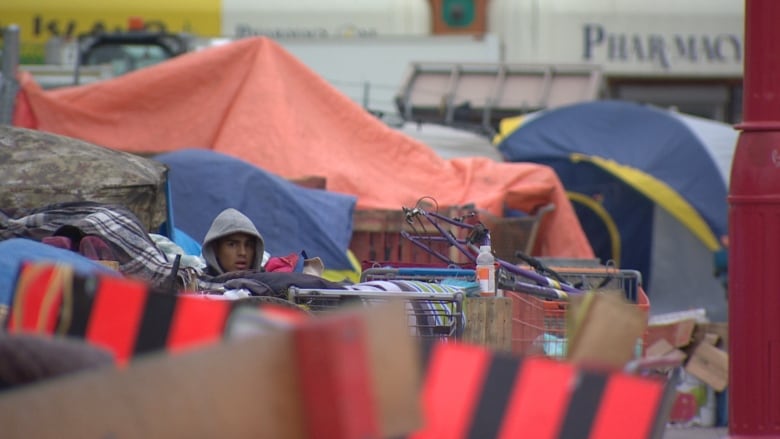Downtown homeless encampments prompt city to ramp up housing efforts
'This approach might take a little bit longer, but it will hopefully lead to better outcomes'

The City of Edmonton says it's boosting efforts to get people sleeping rough into housing amid an increase in downtown homeless encampments and as temperatures dip below zero degrees.
An encampment response team, headed by Homeward Trust, has been meeting weekly since Sept. 25 to co-ordinate housing for roughly 400 people sleeping rough on any given night in Edmonton, says Christel Kjenner, the city's director of housing and homelessness.
The new team places an onus on connecting people with a range of services, from housing workers to healthcare services, in an effort to find a path to sustainable housing, Kjenner says.
"Unless we know the people who are staying there, unless we know their names and their stories, it's difficult for us to come up with meaningful housing solutions," she said.
"This approach might take a little bit longer, but it will hopefully lead to better outcomes."
Enforcement not a long or medium term solution, city says
A homeless encampment is often displaced by bylaw officers within days of a 311 complaint, Kjenner says. But strict enforcement repeats a cycle of displacement.
"Enforcement as a solution, on its own, is not a long-term solution. It's not even a medium-term solution," Kjenner said.
"We can spend a lot of time and energy shuffling people around," Kjenner said. "But ultimately, the root cause of them sleeping outside is that they have nowhere else to go."

The city estimates it spends $1.7 million annually to displace and clean up homeless encampments.
'This time of year, people begin to get very anxious'
CBC News spoke with three housing agencies, who all noted a recent increase in the number of downtown encampments. Kjenner says the camps are an opportunity for the response team to quickly connect with people sleeping rough, as compared to when camps are spread across the river valley.
Outside Hope Mission, one of the city's largest shelters, there are more than two dozen tents, with smaller encampments outside Bissell Centre and Boyle Street Community Services.
There is no single explanation behind the spike in encampments, says Julian Daly, executive director of Boyle Street. But he says the rainy summer, combined with an uptick in the number of camps cleared, have pushed people out of the river valley and into downtown.

The city cleared 2,250 encampments last year, according to a city commissioned report,140 more than in 2017.
And as temperatures fall, Daly says people are moving closer to drop-in centres.
"This time of year, people begin to get very anxious. You can actually feel the mood change in our centre," Daly said. "You don't normally see camps on the streets or around the building, but this year there's been a noticeable increase.
"The camps may be unsightly to people, but for the people in them, that's their home."
'A light at the end of the tunnel'
Laura Janvier is preparing for a second consecutive winter of sleeping rough. A pile of warm clothes is folded outside her tent. Inside, a makeshift coffee table sits atop two thin carpets. In the warm light of day, two unlit candles stick out of a milk carton.
The 39-year old says she came to the city from Cold Lake First Nation several years ago, in hopes of finding more support in Edmonton after her home on reserve was condemned because of mould.
But now she is among roughly 1,600 people experiencing homelessness in the city. Around half are Indigenous, according to data collected by Homeward Trust.
"It just takes a lot of energy and I'm sleep deprived. Having to feel like begging for basic needs, such as clothing," she said.
Over the past two years, Janvier says she has only used a shelter fives times, in moments of exhaustion or during a bitter cold snap.
"There's women screaming and I just couldn't have a comfortable sleep," she said, adding that she finds the shelter unsafe, and worries about giving up valuable possessions during intake.

By working across multipleagencies, the new response team is able toquickly identify any available beds in the city's housing stock, says Kjenner, the city's director of housing.
The city is also looking at interim housing options from leasing private spaces to building modular homes, a temporary solution recently adopted by theCity of Vancouver. Kjenner says a report on interim solutions is expected before city councillors at the end of November.
But the focus remains on the long-term solution of more permanent supportive housing units. The city has put up $40 million to cover the cost of land for 900 units. In recent budget submissions, the city asked the province for $124 million over seven years to help with capital costs. It's also looking to the federal government for $80 million through the National Housing Strategy.
Janvier, meanwhile, says a home would offer the foundation to build a stable, healthy life after years of uncertainty on the streets.
"Once I'm stable inside of housing, and able to sleep and think clearly,I'm able to focus on my addictions and then from there, move on to other things like education and going back to work," she said.
Janvier would eventually like to facilitate a mental health and addictions counselling group for other Indigenous women.
"To empower them that they can move forward. That there's a light at the end of the tunnel. To stay focused on themselves."












_(720p).jpg)


 OFFICIAL HD MUSIC VIDEO.jpg)
.jpg)



























































































